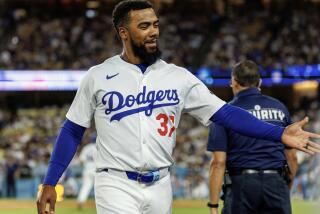There’s Trouble in Riverside
RIVERSIDE — Bonds is stationed on the first base side, watching Griffey play center field.
Now how often does that happen during a baseball season?
A couple of times during spring training maybe? Once during the All-Star game?
At the Riverside Sports Center, home of the Class-A Riverside Pilots, it happens quite often.
OK, so maybe we’re not talking about Barry Bonds, the San Francisco Giants’ star left fielder, or even his father Bobby, the Giants’ first base coach.
Truth be told, we’re not talking about Ken Griffey Jr., the Seattle Mariners’ young star, either.
But at least we have the same families. And, this being minor league baseball, shouldn’t that be enough?
In Riverside, it appears not. The Pilots, an affiliate of the Seattle Mariners, average 1,004 in attendance, last in the 10-team California League. As it is, the club might not be a success at the turnstile even if its roster included a couple of real big-league box office draws.
Craig Griffey, Ken Jr.’s younger brother, plays center and doesn’t appear to be filling seats. Nor do people seem particularly eager to rub elbows with the arms that used to rock Bobby and Barry.
Elizabeth Bonds, Bobby’s mother and Barry’s grandmother, is one of the Pilots’ few faithful fans. She lives a short distance from the stadium and is taken to the game by Leon Culpepper, a childhood friend of Bobby’s who is the club’s public-address announcer.
From a wheelchair parked halfway up the bleachers on the first base side, Bonds quietly watches the action with a small gathering of family and friends.
She prefers anonymity, but once engaged in conversation, Grandma Bonds makes a couple of confessions:
1) Class A is not her favorite brand of baseball. The big leagues isn’t either. She prefers Little League.
“Those little ones, they try so hard,” she said.
2) She wouldn’t know Craig Griffey from Craig Colbert. Or, for that matter, Ron Villone, the Pilots’ highly regarded left-hander, from Sam Malone.
“I don’t know any of these boys’ names,” she said. “I just like to come and watch. Other than just watching, I don’t pay any attention.”
She is not alone.
The Pilots and the High Desert Mavericks are in a spirited race for the second-half Southern Division championship but Greg Shockey, the Pilots’ left fielder, says it is apparent to him that some Riverside fans don’t quite know what they are watching.
“The other day I got asked, ‘Do you guys get paid for that?’ ” Shockey said.
Like many minor league teams, the Pilots offer incentives to youngsters who chase down foul balls and batting practice home runs that are hit outside the stadium grounds. Unlike other clubs, the Pilots do not tender game tickets for payment. They give baseball cards.
“The kids would rather have the cards than tickets,” said Tom Bannon, Riverside’s assistant general manager.
Ouch! When reality hits, it strikes hard.
It could be that the Pilots, as new kids in town, are simply experiencing growing pains. The club moved from Reno in January, three months before the season opener.
“We’re still finding our way around town,” said Jack Patton, the club’s general manager, while sitting in his small and cluttered office at the stadium. “We’re looking forward to getting this season behind us and starting again when we have a whole year to plan.”
Even so, the Pilots appear headed toward more turbulence.
The Sports Center is at the far east end of the city, adjacent to UC Riverside. From the highly populated west end, fans can make the freeway drive to Anaheim Stadium to see the Angels almost as fast as they can maneuver through city streets to see a Pilots game.
“We’re not in a heavy residential area and we’re not centrally located,” Patton said.
That’s an 0-and-2 count. A city ordinance prohibiting the sale of beer at the stadium could be strike three.
Patton says marketing analysis tells him that that the average minor league fan spends a little more than a dollar per game on beer. He assumes the team makes up some of that loss by selling other beverages, but he can only guess how much the ban on alcohol hurts attendance.
“One of the first questions we hear when we go out and talk to people is, ‘Do you have beer yet?’ ” Bannon said. “Whether it keeps them away or not, I don’t know. But they’re curious.”
Added Patton: “Everything we do out here caters to families. Some people, I’m sure, like us better because we don’t have beer. But most people don’t like to have that right taken away, whether they’re beer drinkers or not.”
Alcoholic beverages are prohibited at the park because the Sports Center is within 100 feet of a residential zone.
“The college doesn’t object, and it’s not the city,” Patton said. “The problem is a handful of residents, and I don’t think they object so much to having alcohol here as they do to having a ball team.
“They don’t want the increase in traffic and the perceived increase in noise. They’re using the beer issue as a way to squeeze us out.”
The former Riverside Red Wave played at the Sports Center three years before relocating to Adelanto, near Victorville, to become the High Desert Mavericks in 1991. Riverside’s current franchise might leave as well.
The club has a four-year lease with the city, which maintains the Sports Center facility. However, a clause in the contract enables the Pilots to break the lease if the franchise cannot obtain a beer license.
Rumors have the team moving to a new facility in Moreno Valley.
Where there is a new ballpark, it seems, teams will come. And so will legions of fans.
What happened with High Desert, Patton says, is a prime example. In the franchise’s three years in Riverside, the team drew 223,083 fans. In its first two seasons playing in a new facility, the team played before crowds totaling 423,082.
“They do the same promotions and the same things up there (that) they did here in Riverside,” Patton said. “But what a difference.”
Facility restrictions have chased California League franchises from cities before. In 1986, an ownership group headed by former Dodger Ken McMullen bought a Class-A club based in Lodi, 20 miles north of Stockton, and moved it to Ventura County.
The Ventura Gulls lasted one season, primarily because their home field at Ventura College lacked lights and the club failed to secure a license to sell beer.
The following year, McMullen’s group sold the club to a partnership that included actor Mark Harmon and the franchise moved again, this time to San Bernardino, where it led the league in attendance five consecutive seasons.
That franchise has since moved to a new $11-million stadium in Rancho Cucamonga, where it is on pace to draw close to 325,000 fans--more than 100,000 above the league record.
For the Pilots, conditions in Riverside are, if nothing else, better than what they were accustomed to.
In Reno, cold, blustery weather made early season games uncomfortable, if not torturous. Also, major league organizations had reservations about sending young prospects to a city with 24-hour gambling and night life.
Patton said he doubts that the Mariners would have signed a player-development contract with his organization if the club were still based in Nevada.
The field itself was another problem. The stadium in Reno was rented by the city for use all but four days during the season, including the time the team was out on the road.
Players say the surface at the Sports Center is the worst in the league’s Southern division. However, they also say the field rates favorably with the top fields in the northern half of the league.
“This field isn’t very nice, but it’s still a lot better than ours,” Central Valley (Visalia) pitcher Jason Hutchins said. “And Modesto is probably even worse than ours.”
Actually, the Sports Center is among the most picturesque ballparks in the league. Mountains beyond the outfield fence form an attractive background.
Unfortunately, peaks and valleys also exist on the field.
The Sports Center outfield sways. Starting near the warning track, the outfield grass slopes toward the infield. Then, just before the infield dirt, it bubbles up again.
“Yeah,” said Shockey, a former Cal State Northridge player. “This place is kind of a wreck that way.”
A Riverside ballgame is not the slick promotional package one sees at, say, Rancho Cucamonga.
Before a game in June, a group from P.A.B.--People Against Boredom--performed the national anthem. P.A.B. is a group of musicians from Rubidoux High, who earned its anthem gig simply by placing a telephone call to Bannon.
Bannon asked the caller if his group had ever sung the Star-Spangled Banner before an audience. “We don’t sing,” the young man replied. “We blow.”
“People just call and ask,” Bannon said. “We let them. In four years we haven’t been burned yet.” He paused. “Actually, I take that back. Four years ago we got burned by a player. He forgot the words, then said, ‘Oh (expletive)!’ ”
A few minutes before game time, V.J. Sharna surveys the crowd. “We have some kids tonight,” he said. “We gotta get that Hokey-Pokey going.”
Sharna, the Pilots’ mascot, is supposed to be an Elvis look-a-like.
Workers in the Pilots’ front office refer to him as, “K mart Elvis.” Word is, he is the worst mascot in the league.
Hutchins, the Central Valley pitcher, finds that hard to believe. “No way can he be worse than Rocky, the squirrel at Visalia,” he said while walking from the Rockies’ bullpen to the dugout.
A few innings later, on a return stroll to the bullpen, Hutchins changes his tune. “Burrr-utal!” he said, shaking his head.
Sharna does the Hokey-Pokey with a group of youngsters in the bleachers behind the third base dugout and then disappears. Late in the game, a boy is asked where Elvis went.
“I don’t know and I don’t care,” he said.
Sadly, it appears the same might soon be said about the Pilots.
More to Read
Go beyond the scoreboard
Get the latest on L.A.'s teams in the daily Sports Report newsletter.
You may occasionally receive promotional content from the Los Angeles Times.











